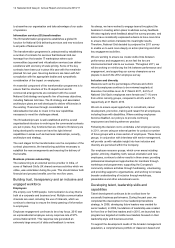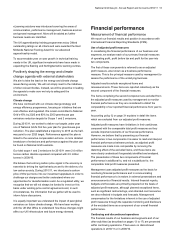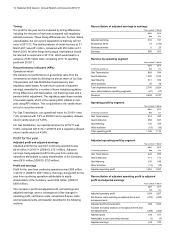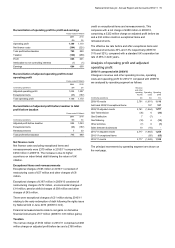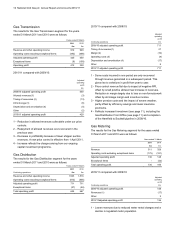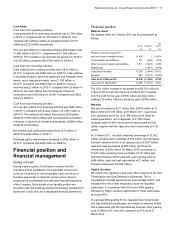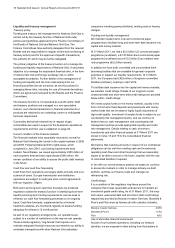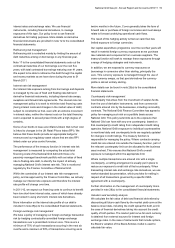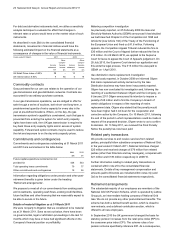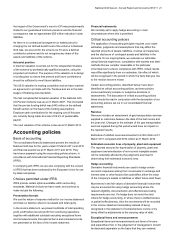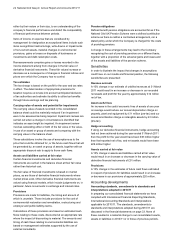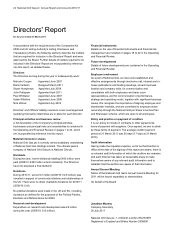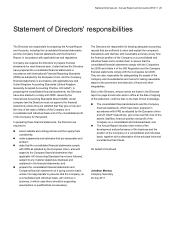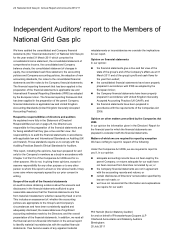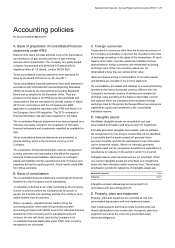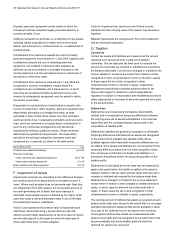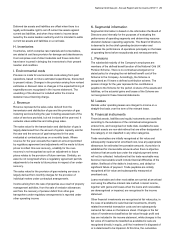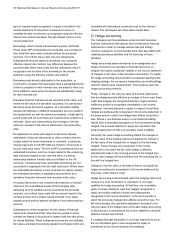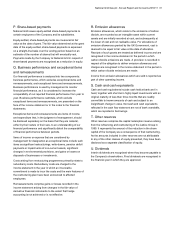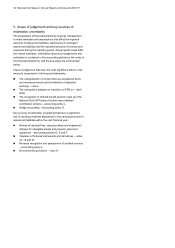National Grid 2011 Annual Report Download - page 24
Download and view the complete annual report
Please find page 24 of the 2011 National Grid annual report below. You can navigate through the pages in the report by either clicking on the pages listed below, or by using the keyword search tool below to find specific information within the annual report.22 National Grid Gas plc Annual Report and Accounts 2010/11
either by their nature or their size, to an understanding of the
company’s financial performance and distort the comparability
of financial performance between periods.
Items of income or expense that are considered by
management for designation as exceptional items include such
items as significant restructurings, write-downs or impairments
of non-current assets, material changes in environmental
provisions, gains or losses on disposals of businesses or
investments and debt redemption costs.
Remeasurements comprise gains or losses recorded in the
income statement arising from changes in the fair value of
derivative financial instruments. These fair values increase or
decrease as a consequence of changes in financial indices and
prices over which the Company has no control.
Tax estimates
The tax charge is based on the profit for the year and tax rates
in effect. The determination of appropriate provisions for
taxation requires us to take into account anticipated decisions
of tax authorities and estimate its ability to utilise tax benefits
through future earnings and tax planning.
Carrying value of assets and potential for impairments
The carrying value of assets recorded in the consolidated
balance sheet could be materially reduced if an impairment
were to be assessed as being required. Impairment reviews are
carried out when a change in circumstance is identified that
indicates an asset might be impaired. An impairment review
involves calculating either or both of the fair value or the value-
in-use of an asset or group of assets and comparing with the
carrying value in the balance sheet.
These calculations involve the use of assumptions as to the
price that could be obtained for, or the future cash flows that will
be generated by, an asset or group of assets, together with an
appropriate discount rate to apply to those cash flows.
Assets and liabilities carried at fair value
Certain financial investments and derivative financial
instruments are carried in the balance sheet at their fair value
rather than historical cost.
The fair value of financial investments is based on market
prices, as are those of derivative financial instruments where
market prices exist. Other derivative financial instruments are
valued using financial models, which include judgements on, in
particular, future movements in exchange and interest rates.
Provisions
Provisions are made for liabilities, the timing and amount of
which is uncertain. These include provisions for the cost of
environmental restoration and remediation, restructuring and
employer and public liability claims.
Calculations of these provisions are based on estimated cash
flows relating to these costs, discounted at an appropriate rate
where the impact of discounting is material. The amounts and
timing of cash flows relating to environmental liabilities are
based on management estimates supported by the use of
external consultants.
Pension obligations
Defined benefit pension obligations are accounted for as if the
National Grid UK Pension Scheme were a defined contribution
scheme as there is neither a contractual arrangement, nor a
stated policy under which the Company is charged for the costs
of providing pensions.
A change in these arrangements may lead to the Company
recognising the cost of providing pensions on a different basis,
together with a proportion of the actuarial gains and losses and
of the assets and liabilities of the pension scheme.
Sensitivities
In order to illustrate the impact that changes in assumptions
could have on our results and financial position, the following
sensitivities are presented:
Revenue accruals
A 10% change in our estimate of unbilled revenues at 31 March
2011 would result in an increase or decrease in our recorded
net assets and profit for the year by approximately £12 million
net of tax.
Asset useful lives
An increase in the useful economic lives of assets of one year
on average would reduce our annual depreciation charge on
property, plant and equipment by £11 million (pre-tax) and our
annual amortisation charge on intangible assets by £3 million
(pre-tax).
Hedge accounting
If using our derivative financial instruments, hedge accounting
had not been achieved during the year ended 31 March 2011
then the profit for the year would have been £38 million higher
than that reported net of tax, and net assets would have been
£29 million higher.
Assets carried at fair value
A 10% change in assets and liabilities carried at fair value
would result in an increase or decrease in the carrying value of
derivative financial instruments of £51 million.
Provisions
A 10% change in the estimates of future cash flows estimated
in respect of provisions for liabilities would result in an increase
or decrease in our provisions of approximately £20 million.
Accounting developments
Accounting standards, amendments to standards and
interpretations adopted in 2010/11
In preparing our consolidated financial statements we have
complied with International Financial Reporting Standards,
International Accounting Standards and interpretations
applicable for 2010/11. The standards, amendments to
standards and interpretations adopted during 2010/11 are
discussed in the financial statements on page 33. None of
these resulted in a material change to our consolidated results,
assets or liabilities in 2010/11 or in those of previous periods.


